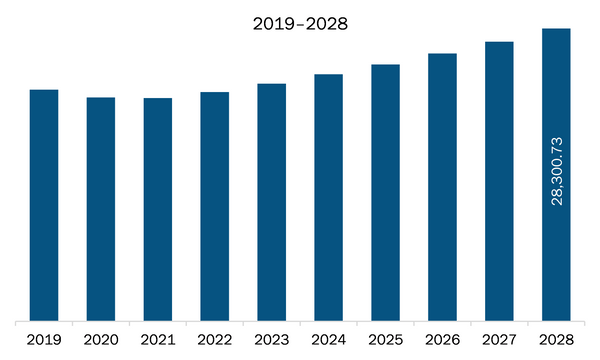Page Updated:
Oct 2021
The Asia Pacific metal nanoparticles market is expected to grow from US$ 9,164.25 million in 2021 to US$ 28,300.73 million by 2028; it is estimated to grow at a CAGR of 17.5% from 2021 to 2028.
Metal nanoparticles are basically engineered materials having at least one dimension in size range of 10–100nm.These particles have exceptional properties which includes the likes of high aspect ratio and uniform size are used in a wide spectrum of applications such as catalysis, medical, and energy storage. The metal nanoparticles are made from nanoscale matters consisting of both organic and inorganic materials combined with different metals. The metal component plays an important role in their application as green catalysts, which is attributed to their larger surface-area-to-volume ratio than the bulk material. There has been an increase in focus for the development of green catalysts that are eco-friendly and re-usable, which helps in minimizing waste; moreover, these catalytic materials are considered indispensable. Metal nanoparticles with high surface areas and more active sites increase the rate and yield of reactions. Gold nanoparticles are used in various chemical reactions as a catalyst. The surface of gold nanoparticles can be used for selective oxidation. Platinum nanoparticles, which have high dispersibility and catalytic activity, are widely being used in electrocatalytic oxidations in fuel cells. Applications of copper nanoparticles in nanotechnology include catalytic organic transformation, electrocatalysis, and photocatalysis. Thus, the increasing use of metal nanoparticles as catalysts with the growing popularity of green catalysts is driving the metal nanoparticles market.In Asia Pacific, India reported a huge number of COVID-19 cases, which led to the discontinuation of several business operations, including metal nanoparticles manufacturing activities. However, various research has been ongoing for the utilization of gold nanoparticles for COVID testing kits, that will provide the results in a matter of minutes. A group of researchers claims that they have developed a diagnostic test that can detect the SARS-CoV-2 (causative agent of COVID-19) within 10 minutes of test and the results will be visible to naked eyes. The test is a simple colorimetry-based assay that uses gold nanoparticles that are capped with the nucleic acid sequence of the nucleocapsid phosphoprotein of the virus. The test is based on the determination of specific antibodies that are developed in response to the infection. Thus, a surge in the use of gold nanoparticles in the healthcare sector, particularly in the development of rapid COVID-19 test kits, is boosting the metal nanoparticles market.
With the new advancements and technologies, vendors can attract new customers and expand their footprints in emerging markets. This factor is likely to drive the Asia Pacific metal nanoparticles market. There has been an increase in the demand for metal nanoparticles from developing countries. Metal nanoparticles are highly being used in industries such as pharmaceuticals and healthcare, electrical and electronics, and cosmetics in these countries. Metal nanoparticles are being used in the healthcare industry for the lateral flow diagnostic testing products which specifically targets heart diseases. In some of the developing economies, metal nanoparticles are being used in solar applications, photocatalytic applications, and cancer therapeutics. In Vietnam, metal nanoparticles are being used in pesticides. Thus, developing countries are providing notable growth opportunities to the metal nanoparticles market players.
Asia Pacific Metal Nanoparticles Market Revenue and Forecast to 2028 (US$ Million)

- This FREE sample will include data analysis, ranging from market trends to estimates and forecasts.
Asia Pacific Metal Nanoparticles Market Segmentation
Asia Pacific Metal Nanoparticles Market – By Metal
- Platinum
- Gold
- Silver
- Iron
- Titanium
- Others
Asia Pacific Metal Nanoparticles Market – By End-Use Industry
- Pharmaceutical and Healthcare
- Electrical and Electronics
- Chemicals
- Personal Care and Cosmetics
- Others
Asia Pacific Metal Nanoparticles Market – By Country
- Australia
- China
- India
- Japan
- South Korea
- Rest of Asia Pacific
Asia Pacific Metal Nanoparticles Report Scope
| Report Attribute | Details |
|---|---|
| Market size in 2021 | US$ 9,164.25 Million |
| Market Size by 2028 | US$ 28,300.73 Million |
| CAGR (2021 - 2028) | 17.5% |
| Historical Data | 2019-2020 |
| Forecast period | 2022-2028 |
| Segments Covered |
By Metal
|
| Regions and Countries Covered |
Asia-Pacific
|
| Market leaders and key company profiles |
|
- Historical Analysis (2 Years), Base Year, Forecast (7 Years) with CAGR
- PEST and SWOT Analysis
- Market Size Value / Volume - Regional, Country
- Industry and Competitive Landscape
- Excel Dataset
Recent Reports
Testimonials
Reason to Buy
- Informed Decision-Making
- Understanding Market Dynamics
- Competitive Analysis
- Identifying Emerging Markets
- Customer Insights
- Market Forecasts
- Risk Mitigation
- Boosting Operational Efficiency
- Strategic Planning
- Investment Justification
- Tracking Industry Innovations
- Aligning with Regulatory Trends
Our Clients






























Sales Assistance
US: +1-646-491-9876
UK: +44-20-8125-4005
Email: sales@theinsightpartners.com
Chat with us

87-673-9708

ISO 9001:2015




 Get Free Sample For
Get Free Sample For